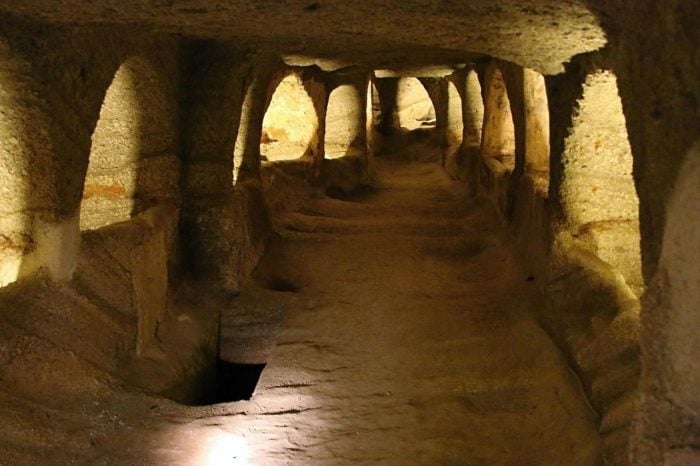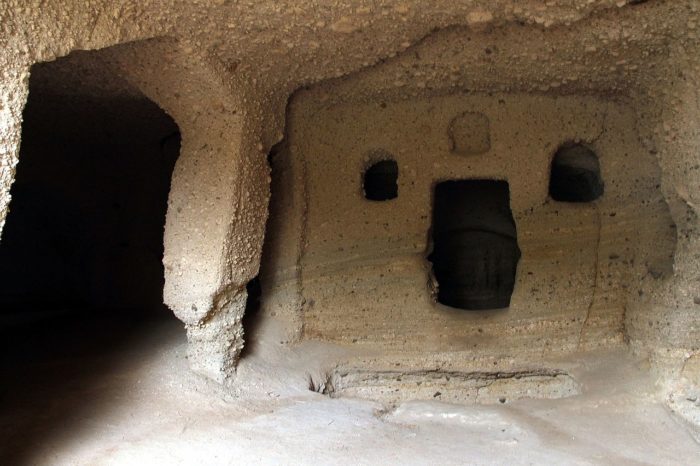
Milos, one of the most beautiful islands of the Cyclades, has a very long history, like all other Greek islands. Although most famous for the discovery of the ancient Venus de Milo statue, the island is also the site of catacombs which tell the tragic story of early Christians in Greece.
According to archaeologists and historians, the awe-inspiring catacombs of Milos have served as the graveyard for 7,000-8,000 Christians, making the site the third most sacred early-Christian monument, after the Holy Land and the catacombs of Rome.
One can certainly say that the catacombs are Milos’ hidden secret for tourists. Along with their fascinating history, the catacombs are a marvel of masterful construction, blending engineering with the natural contours of the bedrock they are carved into.
The catacombs are an underground network with three chambers, five corridors and a funerary chamber. The network is 184 meters long (604 feet), the height of the corridors reaches 2.5 meters (8 feet, 2 inches) and the width ranges from 80 centimeters (31 inches) to 5 meters (16 feet).
Milos catacombs used as tombs for early Christians
Throughout the area with the galleries and caves are carved arches, which are 1.66 meters (5.4 feet) high inside of which are the burial chambers, which were excavated out of the bedrock.
Most of the arches are whitewashed while in the corners there are even traces of red coloring still extant. On the back wall there were inscriptions that unfortunately have not withstood the ravages of the weather and time.
However, some inscriptions have been found, having symbols such as “EN KO” which means “En Kyrio” (for the Lord).
There is also a tomb dug in the rock, called “The Tomb of the Martyr,” which was used by Christians as an altar for their services. There is also an inscription that testifies that there was the tomb of a woman named “Stefanida,” the daughter of Milon.

The catacombs of Milos comprise a rich historical site, marking the various periods of the island.
It was indeed a cemetery but it served other purposes as well, according to the findings.
It was a place of worship that was eventually buried under rocks and soil after an earthquake in the sixth century AD. After that, history became interwoven with legend.
The first person who located the monument near the village of Tripiti, digging far down into the earth was German professor of archeology Ludwig Ross, who was the first to lay eyes on the catacombs in 1843. He dated the intricate underground network to the 1st century AD.
The history of the catacombs is inextricably linked to the mines of the island, which flourished in the second century AD. The markets of Rome were eager for the ores and other materials the rich earth of the Cycladic island produced.
Kissiris, a mineral formed from the thickened foam of volcanic lava, was used to polish the priceless mosaics of temples and houses, while Roman and Greek artists frequently used “militi,” a mineral used as a white paint. Aluminum sulfate was used by doctors, as was the stone called “armenian rock,” while special orders were made for sulfur, used for many purposes.
Thousands of slaves, who were for the most part of newly-converted Christian Greeks, worked in the bowels of the earth both night and day, while Jewish merchants closed the deals, and captains undertook the transportation of the cargo, which passed directly from the entrance of the village of Provatas to the port of Klima.
The slaves also built the infrastructure of the island of Milos, including the large theater.
In 1927, the Greek historian Georgios Sotiriou found a representation of the fish symbol, an early Christian secret symbol coming from the Greek word ΙΧΘΥΣ (fish) forming the acronym for “Jesus Christ, Son of God, Savior” in the catacombs.
See all the latest news from Greece and the world at Greekreporter.com. Contact our newsroom to report an update or send your story, photos and videos. Follow GR on Google News and subscribe here to our daily email!



